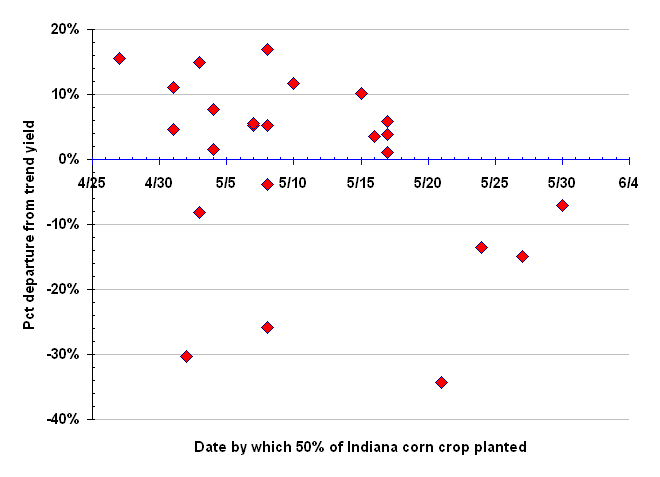

![]() onventional
wisdom says that the prime planting window for achieving optimum corn yields
in much of Indiana opens about April 20 and closes about May 10. This “window”’
typically opens about one week later across the northern tier of Indiana counties
(cooler conditions) and about one week earlier across the southern tier of Indiana
counties (warmer conditions).
onventional
wisdom says that the prime planting window for achieving optimum corn yields
in much of Indiana opens about April 20 and closes about May 10. This “window”’
typically opens about one week later across the northern tier of Indiana counties
(cooler conditions) and about one week earlier across the southern tier of Indiana
counties (warmer conditions).
According to the latest (Apr 9) USDA crop progress report, zero planted corn acres were reported for Indiana (USDA-NASS, 2007). Compared to the 2002-2006 average planted acres for this date, Indiana corn growers are about 3% behind “schedule”. Rainfall occurring throughout the state even as I write will undoubtedly cause further delays to a serious start for planting the 2007 Indiana corn crop.
What are the consequences of a delayed start to planting? How important a predictor of statewide corn yield is planting date anyway? Does late planting in and of itself guarantee lower than normal yields? Interestingly, the planting date effect on statewide yield is somewhat paradoxical.
If one reviews the data for average statewide planting dates and corn yield for the past twenty-four years, there is NOT a strong relationship between the date by which half of the state's corn crop is planted and the subsequent statewide average corn grain yield (Fig. 1). In fact, less than 15 % of the variability in statewide corn grain yield during the past twenty-four years can be explained by planting date.

Fig. 1. Percent departure from trend corn yield in Indiana for 24 years (1983-2006)
and dates by which at least 50% of the state’s corn crop was planted. [Data
source = USDA-NASS].
So what's the deal? Why do agronomists preach about the importance of timely planting and yet the statewide statistical data do not appear to substantiate this importance? Let me try to explain.
The reality is that corn grain yield potential does indeed decline, on average, by one to two bushels per acre per day of delayed planting after about May 10. That means, for example, that corn planted on May 30 would be expected to yield from 20 to 40 bushels less than corn planted before May 10. Delayed planting beyond early May will typically result in lower corn yields because of a number of factors, including a shorter growing season, insect & disease pressure, and moisture stress during pollination. Indeed, the data in Fig. 1 show that the four years with the greatest delay in planting at least 50% of the crop were years with yields significantly lower than trend.
The good news is that planting date is but one of many yield influencing factors (YIFs) for corn. All of the other YIFs interact with planting date to determine the overall yield potential for any given year. In other words, although we know that early-planted corn will usually yield more than later-planted corn, the exact or absolute yield level is dependent on a host of other YIFs. Therefore, it is possible for early-planted corn in one year to yield more than, less than, or equal to later-planted corn in another year depending on the exact mix of YIFs for each year. That is the reason why statewide average corn grain yields frequently vary by plus or minus 10% from the expected trend yield from year to year.
For example, the crop years 1997 and 2000 represent early and late planting dates in Indiana. The date by which half of the state's corn crop was planted in 1997 and 2000 was May 3 and May 17, respectively. Yet, the earlier planted 1997 crop yielded 8.2% BELOW trend yield for that year and the later planted 2000 crop yielded 5.8% ABOVE trend yield according to the Indiana Agricultural Statistics Service. Why? Different YIFs in different years.
Bottom Line: Don't carried away about the influence of planting date on total corn production. “Mudding in” a crop early to avoid planting late will almost always end up being an unwise decision. While important, planting date is only one of many yield-influencing factors for corn.
USDA-NASS. 2007. Crop Progress (9 Apr). USDA-NASS, Washington, D.C. [On-Line]. Available at http://usda.mannlib.cornell.edu/usda/current/CropProg/CropProg-04-09-2007.pdf. (URL verified 4/11/07).
© 2007 , Purdue University, an equal access, equal opportunity university. This material may be available in alternative formats. If you have trouble accessing this page because of a disability, please contact RLNielsen at rnielsen@purdue.edu.